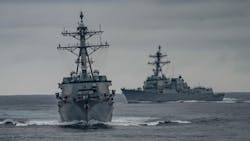Raytheon to build hardware for shipboard Air and Missile Defense Radar (AMDR) aboard U.S. Navy destroyers
WASHINGTON – Shipboard radar experts at Raytheon Technologies Corp. will build hardware for the new AN/SPY-6(V) Air and Missile Defense Radar (AMDR), which will be integrated into late-model Arleigh Burke-class (DDG 51) Aegis destroyers, under terms of a $422.7 million U.S. Navy order announced Monday.
Officials of the Naval Sea Systems Command in Washington are asking the Raytheon Missiles & Defense segment in Marlborough, Mass., for AN/SPY-6(V) shipboard radar hardware. Within the last two months Raytheon has received two orders for AMDR radar system hardware worth nearly $1.1 billion.
The Raytheon AN/SPY-6(V) AMDR will improve the Burke-class destroyer's ability to detect hostile aircraft, surface ships, and ballistic missiles, Raytheon officials say. The AMDR will supersede the AN/SPY-1 radar, which has been standard equipment on Navy Aegis Burke-class destroyers and Ticonderoga-class cruisers.
The new shipboard radar will go aboard Flight III Burke-class destroyers. Thus far one Flight III Burke-class destroyer has been launched: the USS Jack H. Lucas (DDG 125), which is set for commissioning in 2023.
A construction contract has been awarded for the USS Louis H. Wilson Jr. (DDG 126), which should be commissioned in 2024. The keel has been laid for the USS Ted Stevens (DDG 128), which has no commissioning date set.
Flight III Burke-class destroyers approved for construction are the USS Jeremiah Denton (DDG 129); USS William Charette (DDG 130); USS George M. Neal (DDG 131; USS Quentin Walsh (DDG 132); USS Sam Nunn (DDG 133); USS John E. Kilmer (DDG 134); USS Thad Cochran (DDG 135; the USS Richard G. Lugar (DDG 136); the USS John F. Lehman (DDG 137); and the Telesforo Trinidad (DDG 139). One Flight III destroyer (DDG 138) is approved for construction, but as yet is unnamed.
The new Flight III versions of the Burke-class destroyers will be built at Huntington Ingalls Inc. in Pascagoula, Miss., and at the General Dynamics Corp. Bath Iron Works segment in Bath, Me. Flight III is the latest version of the Burke-class guided missile destroyer.
The AN/SPY-6(V) AMDR will provide greater detection ranges, increased discrimination accuracy, higher reliability and sustainability, and lower costs, compared to the AN/SPY-1D(V) radar onboard today’s Burke-class destroyers.
The system is built with individual building blocks called radar modular assemblies (RMAs), Raytheon officials say. Each RMA is a self-contained radar in a two-cubic-foot box; RMAs can stack together to form any size array to fit ship mission requirements.
The inherent scalability of the AN/SPY-6(V) AMDR also could enable new instantiations, such as backfits on existing Burke-class destroyers and installation on aircraft carriers, amphibious warfare ships, frigates, the littoral combat ship, and Zumwalt-class land-attack destroyers without significant new radar development costs, Raytheon officials say.
For the Flight III Burke-class destroyer's SPY-6(V) AMDR will feature 37 RMAs. The new radar will be able to see targets half the size at twice the distance of today’s SPY-1 radar. The AMDR will have four array faces to provide full-time, 360-degree situational awareness. Each 14-by-14-foot face is about the same size as today’s SPY-1D(V) radar.
The AN/SPY-6(V) AMDR will 30 times more sensitive than the AN/SPY-1D(V) in the Flight III configuration, and is being designed to counter large and complex raids, Raytheon officials say. The new radar will have adaptive digital beamforming and radar signal processing for dealing with high-clutter and jamming environments.
The AN/SPY-6(V) radar also is reprogrammable to adapt to new missions or emerging threats. It uses high-powered gallium nitride (GaN) semiconductors, distributed receiver exciters, adaptive digital beamforming, and Intel processors for digital signal processing.
The new radar will feature S-band radar coupled with X-band horizon-search radar, and a radar suite controller (RSC) to manage radar resources and integrate with the ship’s combat management system.
On this order Raytheon will do the work in Andover, Mass; Scottsdale, Ariz.; San Diego, Calif; Sykesville, Md.; Syracuse, N.Y.; Stafford Springs, Conn.; Hanahan, S.C.; Indianapolis; Cerritos, Riverside, and Newark, Calif.; Huntsville, Ala.; Portsmouth, R.I.; Dallas; Tulsa, Okla.; and Eau Claire, Wis., and should be finished by September 2025. For more information contact Raytheon Missiles & Defense online at www.raytheonmissilesanddefense.com, or Naval Sea Systems Command at www.navsea.navy.mil.
About the Author
John Keller
Editor-in-Chief
John Keller is the Editor-in-Chief, Military & Aerospace Electronics Magazine--provides extensive coverage and analysis of enabling electronics and optoelectronic technologies in military, space and commercial aviation applications. John has been a member of the Military & Aerospace Electronics staff since 1989 and chief editor since 1995.
